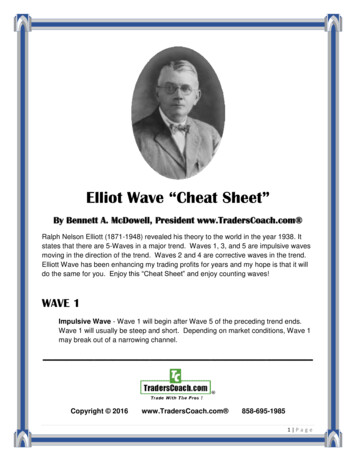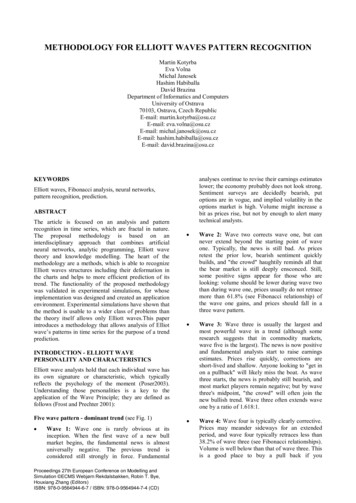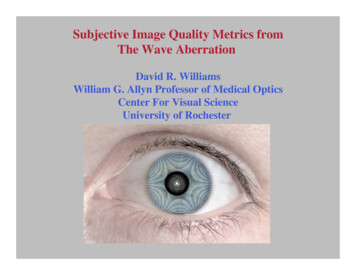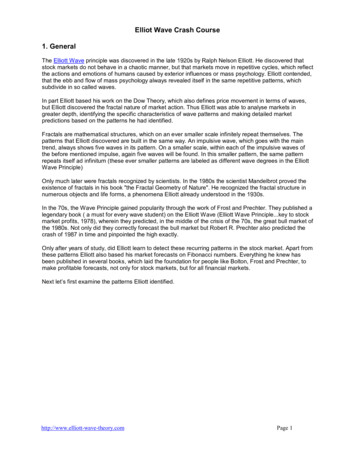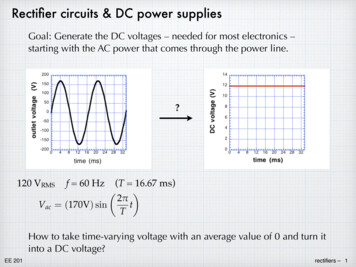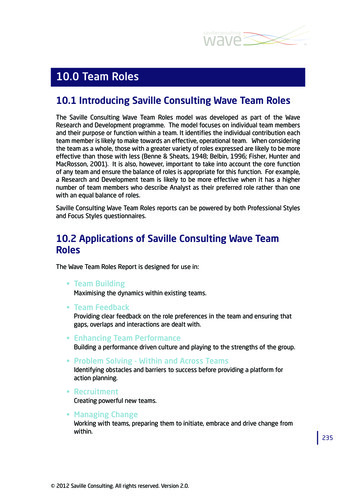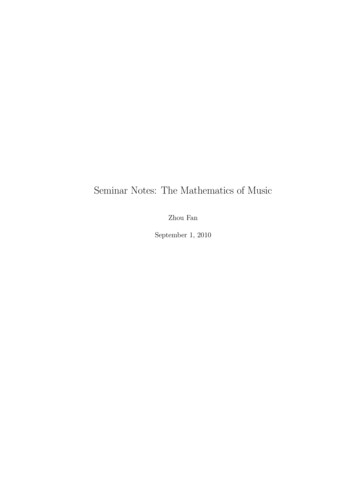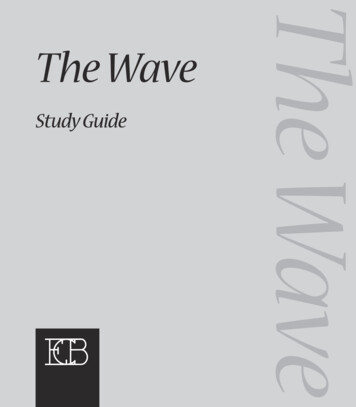
Transcription
Study GuideEThe WaveThe Wave
Table ofContentsintroduction4Pre-Reading5chapterS 1-176-39Basic Understandingvocabulary practiceunderstanding the textAnalysis and InterpretationPost-Reading40Bridging Text and Context40Reflection41Appendix of Higher-Order Thinking Skills42Appendix of Literary Terms45(Summative Assessment appears in the Teacher’s Guide)
INTRODUCTIONThis Study Guide is directed toward 5-point students who will take either the Bagrut Literature exam(Module F) or do the Log (school-based assessment). The Study Guide carefully follows the LiteratureModule Program for teaching and assessing literature. It integrates Higher-Order Thinking Skills (HOTS)using the methodologies that have been specified by the Ministry of Education and following the KeyComponents laid out by the Ministry (see below). HIGHER-ORDER THINKING SKILLS (HOTS)Students are required to learn and apply three HOTS when studying a novel. In this Study Guide, wefocus on three HOTS that we believe are most suitable for analyzing The Wave: Predicting,Distinguishing Different Perspectives, Evaluating.KEY COMPONENTSThe Study Guide contains six of the seven key components of the program. They are presented asfollows:1. Pre-Reading2. Basic Understanding (after each chapter), including Vocabulary Practice and Understanding the Text3. Analysis and Interpretation (after each chapter), including the teaching of literary terms and theHOTS4. Post-Reading (after Chapter 17)5. Bridging Text and Context Activity (after Chapter 17)6. Reflection (after Chapter 17)The seventh component, Summative Assessment, is included in the Teacher’s Guide.APPENDIX OF HIGHER ORDER THINKING SKILLSAn explanation of each of the Higher-Order Thinking Skills is provided in the appendix on pages 42-44.APPENDIX OF LITERARY TERMSLiterary terms are in bolded throughout the Study Guide to indicate that the word appears in theappendix on pages 45-46.
PRE-READINGA12B novel is a made-up story. The novel you are about to read is called The Wave.ALook at a book cover for this novel. It says, THE CLASSROOM EXPERIMENTTHAT WENT TOO FAR. What do you think this experiment is about?Why do you think the novel is called The Wave?To answer the above questions, you used the thinking skill ofPredicting. When you are asked to predict an answer, you consider theinformation available, use your prior knowledge when possible, and thenmake a reasonable assumption.What did you learn by doing the activity in exercise A? C ow is the thinking skill of Predicting helpful in everyday life? Give an exampleHof how it could be useful for you.the wave
chapter 1basic understandingvocabulary practiceReplace the words in bold with the words actically1. Laurie teaches younger students in her free time at school.2. There were very few students around. The hall was almost empty.3. Before Mr. Gabondi could punish Laurie, the bell rang.4. Most students consider Mr. Ross an excellent teacher.5. Some teachers admitted that they were just jealous of Mr. Ross.6. The marks on the papers were not surprising.Understanding The TextAT he characters are the people in a novel. Read the descriptions of the studentsat Gordon High and write who they refer to.Laurie SaundersRobert BillingsDavid CollinsAmy SmithBrian Ammon1. She is a pretty girl with short light-brown hair.2. She is a petite girl with thick, curly hair.3. He is the class loser.4. She is Laurie’s best friend.5. She chews pens when she is upset.6. He is a heavy boy and his hair is always a mess.7. He is a running back on the football team.8. He is Laurie’s boyfriend.9. They always get very good grades.10. They usually get low grades.
BComplete the sentences about the teachers at Gordon High.1. Mr. and Mrs. Ross have been teaching at Gordon High for . .2. Mr. Ross teaches . .3. Mr. Ross is considered to be an . teacher.4. Mrs. Ross teaches . .5. Mr. Gabondi teaches . , and he is very . .Analysis and interpretationAG o back to page 5 and review the thinking skill of Predicting. Use this skill toanswer the questions below.1. In the next chapter, Mr. Ross shows his class a documentary about theHolocaust. How do you think the students will react to this documentary?2. What questions do you think the students will ask Mr. Ross after watching thisdocumentary?BT he setting is the time and the place in which a story takes place. Consider thesetting of the novel. Give two examples that show that this novel is set in the late1960s.CT he writer gives us information that helps us form a clearer picture of thecharacters. This is called characterization. This may include the character’sappearance, actions, words, thoughts and the way other characters relate tohim or her.Complete the chart below.CharacterInformation givenLaurie1. She is the editor-in-chief of TheGrapevine.2. She makes funny faces to entertainAmy.Mr. Ross3. He can’t thread a film through theprojector.4. He tries to teach the students thepractical, relevant aspects of history.What it shows aboutthe characterthe wave
DA nswer the questions.1. What do some of Mr. Ross’s fellow faculty members have against him? Why doyou think they feel this way?2. “I heard it through the grapevine” means information that is passed from oneperson to another. Do you thing The Grapevine is a suitable name for the schoolnewspaper? Explain.3. The first chapter describes a typical American classroom. Compare this classroomto your own. How is it similar? How is it different? Complete the Venn diagrambelow.GordonBothMy Schoolchapter 2basic understandingvocabulary practiceComplete the sentences with the words iodatrocities1. After World War I, there was a . when inflation was high in Germany.2. Some Germans hoped that the Nazis would be able to . the economy.3. Hitler rose quickly through the political . of the Nazi Party.4. Hitler supported the idea that the Germans were a . race.5. By 1934, Hitler had . control of the German government.6. Less that 10 percent of the German . belonged to the Nazi Party.7. The Nazi Party was highly organized, . and dangerous.8. Most Germans said that they didn’t know about the . committed by the Nazis inthe concentration camps.
Understanding The TextAnswer the questions.1. What era is the class studying in history?2. What do the students find hard to understand about the Germans inWorld War II?3. According to Mr. Ross, how did the Germans attempt to excuse their behaviorafter the war?4. Why doesn’t Laurie accept this excuse?5. Why does Mr. Ross want to speak to Robert after the lesson?6. Who is Jeff Billings? Why is he so special?Analysis and InterpretationAG o back to exercise A (Analysis and Interpretation) on page 7. In this section youwere asked to predict the answers to the following questions:1. How do you think Mr. Ross’s students will react to a documentary about theHolocaust?2. What questions do you think the students ask Mr. Ross after watching thisdocumentary? Answer the questions again and compare your predictions to your answers.B T he setting may also refer to the characters’ socio-economic background (socialenvironment). Describe the social environment in which this story takes place.CAnswer the questions.1. What is Robert’s problem? What could he do to solve his problem?2. Why do you think Mr. Ross told Robert that no one expected him to be anotherJeff Billings?3. Do you think Mr. Ross handled the conversation with Robert well? Why or whynot?the wave
chapter 3basic understandingvocabulary practiceChoose the sentence that explains the meaning of the words in bold.1. Robert pretended that he hadn’t noticed the girls’ behavior.a. He noticed their behavior.b. He acted like he didn’t notice their behavior.2. Laurie didn’t have an appetite.a. Laurie was hungry.b. Laurie wasn’t hungry.3. Laurie was completely preoccupied with the film she had seen.a. Laurie was too busy to think about the film she had seen.b. Laurie could only think about the film she had seen.4. The football team is pretty disorganized.a. The players don’t function as a team.b. The players are overzealous.5. Robert was engrossed in a Spider-Man comic.a. He wasn’t interested in the Spider-Man comic.b. He was reading the Spider-Man comic with great interest.6. David’s thoughts drifted to other pressing matters.a. David started thinking about other urgent things.b. David tried to think positively.understanding the textAT wo new characters are introduced in this chapter: Carl and Alex. Write onefact about each student.BAnswer the questions.1. Why can’t Laurie eat?2. In what way would Laurie like David to change?3. What bothers Laurie about her friendship with Amy?4. What practical joke do Carl and Alex play on Laurie and Amy?105. Why do Carl and Alex want to leave all of a sudden?
ANALYSIS AND INTERPRETATIONA1 ompare and contrast David’s and Laurie’s reaction to the documentary theyCsaw in class. Use the Venn diagram below.David2BBothLaurieWho do you agree with? Why?Answer the questions.1. Why does everyone think that Robert is weird? Give examples to support youranswer.2. Do you think Amy is a good friend? Why or why not?chapter 4basic understandingvocabulary practiceComplete the sentences with the expressions below.blank lookwrapped updrives her crazyput his finger on itpursue his thoughtsworth a try1. Something bothered Mr. Ross, but he couldn’t quite .2. Mr. Ross needed a long period of time to . .3. Mr. Ross thought it was to run an experiment in class.4. Mr. Ross didn’t listen to his wife’s story. He had a on his face.5. Mr. Ross can get so . in a subject that he forgets about the rest of his life.6. Sometimes Ben’s involvement in a new subject becomes too much for Christy. Infact, he sometimes .the wave 11
understanding the textAnswer the questions.1. What upsets Mr. Ross at the beginning of the chapter?2. What does Mr. Ross realize after reading a number of books?3. What would Mr. Ross like his class to experience?ANALYSIS AND INTERPRETATIONAI n a flashback the author breaks the storyline to describe events that happenedbefore the story began. The information is usually provided through the memoryof one of the characters. In this chapter Christy has a flashback. What do we learn about Ben in this flashback?BAnswer the questions.1. The writer describes the way Mr. Ross studied a new subject as “almostfrightening”. What do you learn about Mr. Ross from this characterization?2. Do you think Ben and Christie have a good relationship? Why?chapter 5basic understandingvocabulary practiceChoose ALL the words or phrases that can follow the verbs in bold.121. obeyrulesa drill sergeant2. feelexhilarated3. imitatetime4. dismissa class5. loseyour concentration6. snapyour fingers7. issuean order8. standin linecuriousa positiondisciplinepunctuala posturea proposalto attentionan assignmentstifflyprecisea confused looka far crya messlike a rusha commandstrengththe momentum your appetiteatrocitiesa sharp bangstilla blank looka mistake
Understanding The TextAnswer the questions.1. What motto does Mr. Ross write on the board?2. How do the students react to the motto at first?3. Mr. Ross’s first rule is that the students must sit up straight in class. What otherthree rules does he introduce during the lesson?4. According to David, how was this lesson different?5. Does Mr. Ross plan to continue the “game” at the next lesson? Why or why not?6. What does Ben tells Christy about his day at the end of the chapter. Whatdoesn’t he tell her? Why?ANALYSIS AND INTERPRETATIONAAnswer the questions.1. Why does Mr. Ross ask Andrea about her ballet lessons?2. Why do you think Robert accepts the new rules of The Wave so quickly?3. Why do you think the students felt energized after Mr. Ross’s lesson?4. What do you think went through David’s mind as he was watching Robert in themirror?B r. Ross’s “discipline game” was well received in class. Complete the chart toMshow what Mr. Ross is learning about his students and what he is learningabout himself.StudentsMr. Rossthe wave 13
review of characterschapters 1-5 novel has major and minor characters. The major characters are the mostAimportant characters in the novel. The minor characters are less developed; theyhelp advance the story and support the major characters. Complete the chartbelow about the major characters in The Wave.CharacterWhat we knowLaurie Saunders1. She is an excellent student at and she always gets . .2. She is the of The Grapevine.3. Amy is her . .Ben Ross1. He teaches .2. He shows the class a documentary about . .3. He can’t explain why the Germans . .4. He wants his class to experience .David Collins1. Laurie is his . .2. He is the of the football team.3. He wants to study in college.Robert Billings1. He is the class . .2. He lives in the shadow of . .3. He . through the whole documentary. my Smith and Christy Ross are minor characters in The Wave. Complete theAchart below about these characters.Character14What we knowAmy Smith1. Laurie is her .2. She hangs out with Laurie in the publications office, thoughshe isn’t . .Christy Ross1. Ben Ross is her . .2. She teaches at Gordon High.
2. what do the students find hard to understand about the Germans in world war II? 3. according to Mr. Ross, how did the Germans attempt to excuse their behavior after the war? 4. why doesn’t Laurie accept this excuse? 5. why does Mr. Ross want to speak to Robert after the lesson? 6. who is Jeff Billings
